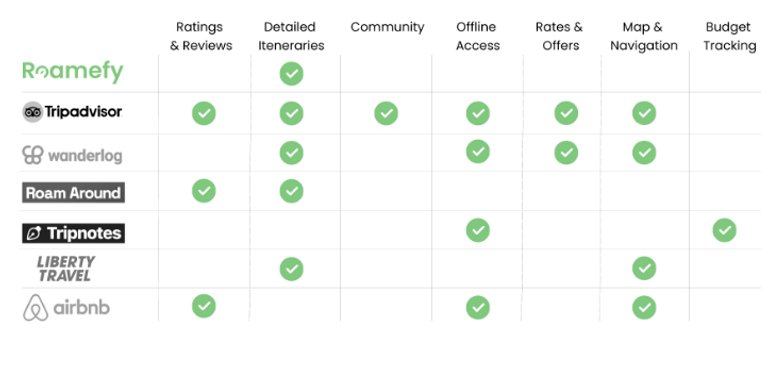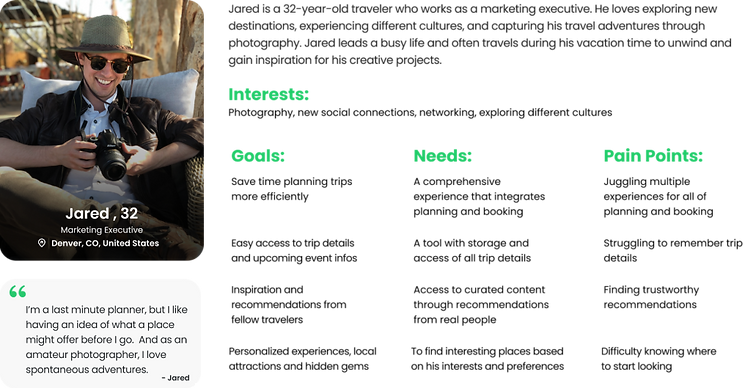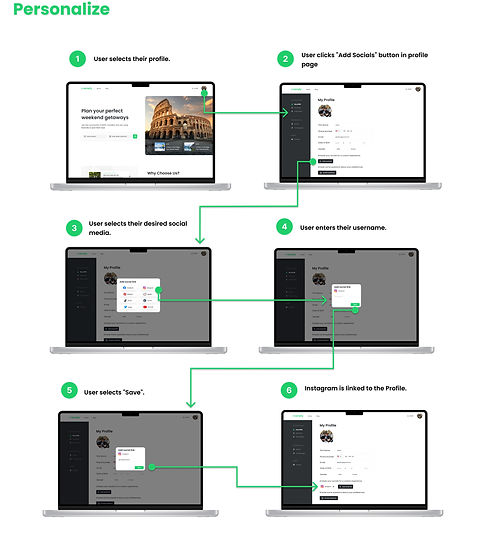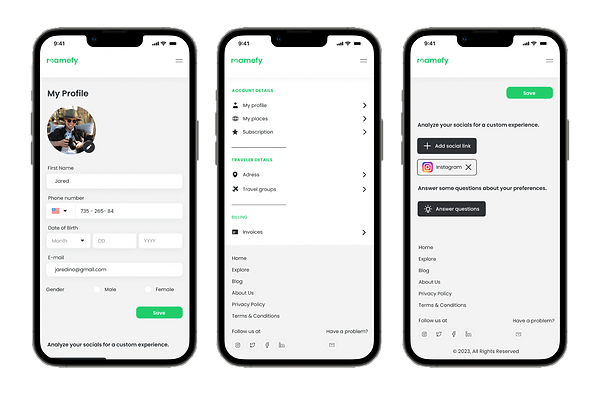
Trip Planning Has Never Been Easier
The Client
Roamefy, is a trip planning tool to help travelers plan their trips within seconds. Trip planning takes hours of research and browsing lots of different resources, Roamefy simplifies this by generating a curated travel itinerary based on traveler preferences.
Tools


What was causing problems?
We know...
Travel planning is a multi-faceted process that can be time-consuming and induce various levels of stress, largely dependent on the specific needs and preferences of individual travelers.
Let’s think about...
How might we alleviate the stressful and time-consuming nature of trip planning while providing a convenient and personalized experience that encourages user engagement, enhances decision-making, and fosters a sense of community connection?
Design Process

Empathize
Let’s take a look at the competition
We conducted a competitive analysis of features to identify Roamefy's unique selling points and areas for improvement in comparison to its competitors. The research findings indicate that Roamefy excels in creating fast and detailed trip itineraries. However, to enhance its competitive edge and better meet customer needs, Roamefy needs to consider more incorporating unique features. Which I will show diving deeper into the case study.

What did we hear from frequent travelers?
With a clear sense of the business, we conducted interviews with 8 potential users to learn more about their usual travel planning steps and understand their pain points and needs. Additionally, some of them shared their experiences of using booking apps and provided us with valuable insights into their approach.

What we learned:
-
We have to construct a website that tailors trip recommendations based on the length of the journey.
-
Our task is to devise a method for users to instantly generate itineraries according to their interests.
-
We must provide a way for people to edit the itinerary by adding or removing tickets, as well as suggesting new activities.
-
We have to offer a method for users to edit the itinerary by adding or removing tickets and suggesting new activities.
-
Our task involves integrating all the features for searching, planning, and booking trip activities into a single website.
-
Creating a responsive web design for multi-purpose use is necessary.
Define
Imagine the traveler we are designing for
Using our findings from the research phase, we created a user personas to represent users with different backgrounds and needs.

What is the traveler’s emotional rollercoaster?
We mapped out the process that Jared would go through before using Roamefy. We learned about Jared’s pain points, frustrations, and emotional experience through each step, in order to see opportunities for new features and elements for our proposed website

To see how the actions and emotions of a user change with Roamefy we also created a proposed user journey. By creating a user journey for Jared using Roamefy, we can gain insights into how he may react and feel upon learning about the product and using it.

Ideate
What are the must-have features the product needs?
We took the core insights we discovered in business research and user research to guide our design process. To help us prioritize we split the features from most essential to less essential, but still feasible to build during later stages of the product creation process.

Design
What does Roamefy look like?
With all our research in mind we started working on some sketches which turned into a mid-fidelity prototype and later on into a high-fidelity prototype. This is our final result.



Prototype Walkthrough Video

Roamefy on your phone
No worries! Since our design is responsive, we have also created some iOS mockups to showcase how the website will visually perform on
an iPhone.


Design System
We build a cohesive design layout for this project, to realize our ideas and vision.


Test
Does it work?
To assess the usefulness of our product to users, we conducted two rounds of usability testing involving a total of 5 users. During these sessions, we obtained feedback on mid-fidelity designs and implemented revisions to address any problem areas for our hi-fidelity design.
We tested a couple of screen flows including our new features and here's how our design improved people's experience from round 1 on
mid-fidelity wireframes to round 2 on high-fidelity wireframes:
users completed
the tasks
7 seconds faster
80%
users completed
the tasks
directly
4.6 / 5
we improved
easiness
by 0.4 points
What would be the next steps?
If I had the opportunity to continue working on this project, I'd focus on:
-
Build out a full page of each experience that will provide detailed information on each card of activity.
-
In order to gather data from potential users in the future, we recommend to explore additional groups of people.
-
Create navigation to activity from map with up to date information on location itself.
-
Dive in more to on boarding process, think of potential group of users that might not have social media.
-
Reconsider “thumbs up” functionality, allow people to access the events they liked in the past to have them inspire for new travel plans.
-
Make budget calculator option functional and test how it performs, because budget was huge factor to all users we interview.
Looking back
Working on a UX design project about traveling brought new exciting challenges. With a short timeframe, I had to adapt my process, prioritize tasks, and communicate efficiently. Coordinating with a global team across time zones required careful planning and regular check-ins. Despite the constraints, I enjoyed the opportunity to think creatively and come up with new innovative solutions. The project taught me valuable lessons in project management, communication, and user-centered design. I'm grateful for the experience and look forward to applying these lessons in future projects.
Project Report
The project report includes the full documentation on the Roamefy project.
Specification Document
The user interface specification document captures the visual details and interactions of a user interface to guide developers while building a product.
Other Projects
Starting this project from scratch, me and my team specifically focused on improving the reservation system for public courts in NYC parks. Currently, the system is fragmented, with different parks having various reservation methods, some online and some in-person. We identified this fragmentation as a potential source of frustration for users. Take a look at the solution.
We were assigned of designing a mobile-responsive website centered around social impact. My team and I refined our focus to crafting a platform dedicated to assisting mindful consumers in minimizing food waste within their households.
Take a look at the solution.





